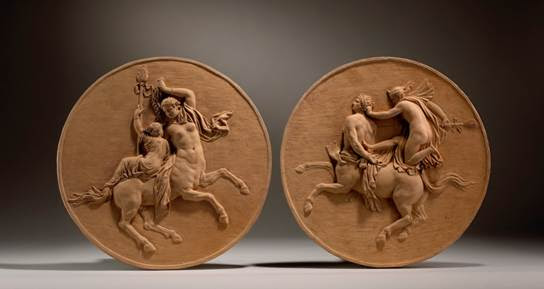These brothers have established a worldwide reputation for finding, exhibiting, and selling some of the highest-quality and rarest sculptures from the Renaissance through Neoclassical periods. This is worth a trip to the Upper East Side.
Tomasso Brothers Fine Art is returning to Manhattan in late January at Carlton Hobbs LLC. It shouldn’t come as a surprise that what they have to offer is truly magnificent, as the Tomasso brothers have long been recognized as among the best dealers and collectors of rare Renaissance and Neoclassical sculpture.
From January 19 to January 28, a number of outstanding works in terracotta, bronze, and marble will grace the spaces of Carlton Hobbs LLC. Among the highlights are a pair of exquisite terracotta relief panels depicting Bacchanalian scenes from Pompeii, created by the great English sculptor John Bacon the Elder, circa 1770. Also turning heads are a rare bronze mythological group by Massimiliano Soldani-Benzi, a newly discovered portrait bust by the Roman Neoclassical sculptor Domenico Cardelli, and a superb bronze by Gian Francesco Susini titled “The Borghese Satyr.”

Discussing the two terracotta reliefs, the brothers say, “A series of frescoes were uncovered at the so-called Villa of Cicero at Pompeii in January 1749 illustrating, amongst other subjects, the revelries of Centaurs and Bacchantes, followers of the god Bacchus. Josiah Wedgwood (1730-1795) had access to the Pompeiian models through the Marquess of Lansdowne (1737-1805). It would seem Wedgwood had the present terracotta roundels faithfully produced after the ancient prototypes around 1770 by John Bacon the Elder, one of the most prominent English sculptors of the period, who collaborated on a number of other occasions with Wedgwood.
“Highly finished, the roundels are the models from which Wedgwood’s white stoneware and black basalt versions of the Centaur reliefs were derived. They display a confident handling of anatomies and a sense of movement that fully does justice to the lithe dynamism of the original Pompeiian frescoes. The roundels constitute a rare and beautiful example of the early resonance of Pompeii’s influence. Formerly in the collection of Dr. Terry Friedman (b. Terence Friedman in Detroit, Michigan), a leading art historian and authority on 18th century architecture, keeper of decorative arts at Temple Newsam historic house (1969-1993) and later principal keeper at Leeds City Art Gallery.”
To learn more, visit Tomasso Brothers Fine Art.
This article was featured in Fine Art Today, a weekly e-newsletter from Fine Art Connoisseur magazine. To start receiving Fine Art Today for free, click here.







